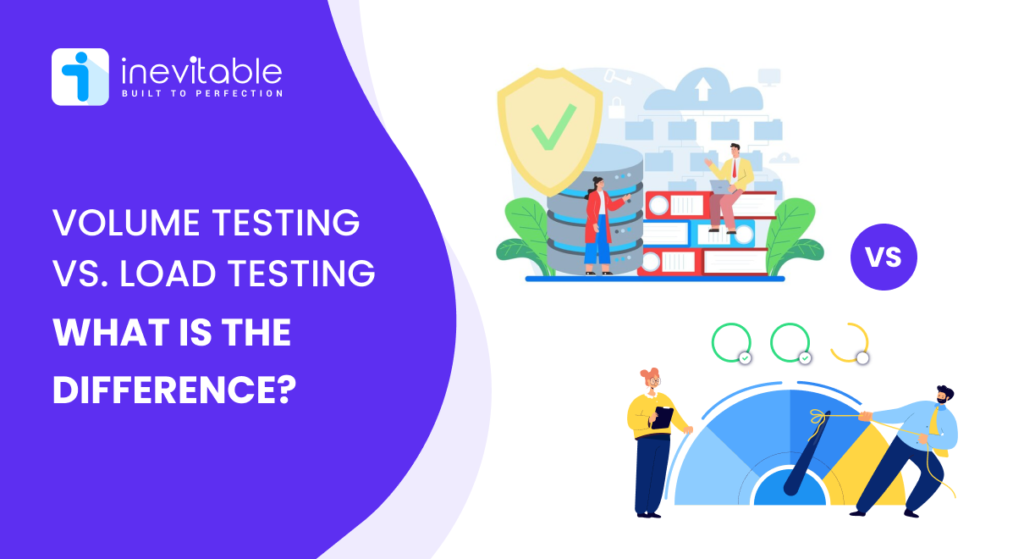
Volume Testing and Load Testing
Volume Testing and Load Testing are both different types of performance testing. Though both these types of software testing are meant to check the optimum performance of the software, they are often confused to be the same. Several factors differentiate these two types of performance testing, and we are here to help you understand the same.
Volume testing is a form of performance testing where the software is tested under a huge volume of data. The main specifications that are tested in volume testing are response time, the point where the software starts deteriorating, and the bandwidth of its database. Whereas, Load Testing is a type of software testing where the system’s behaviour is tested under an expected amount of load. The main aspect that is tested in this kind of testing is whether the software meets end-user expectations or not.
What Is Volume Testing?
Volume testing is a type of non-functional testing. It is also called flood testing, due to the nature of tests that are performed in volume testing. Volume testing in the initial phase of the software development lifecycle (SDLC) helps understand the capacity of the system’s database, discover bottlenecks, and develop a robust software application.
To understand volume testing better, let us consider the following example:
Suppose there is a huge sale event coming up in the calendar. Something as big as Black Friday, or Cyber Monday. Software engineers of all the e-commerce websites and applications will first conduct a volume test to ensure that the system can handle the sudden rise in traffic.
To do so, they will create a virtual test environment, replicating the real-life scenario as closely as possible. This test scenario will consider the use of hardware, software and network configuration to test the system’s strength. Once it is done the testers will use an automated tool to generate a large amount of data (exceeding the bandwidth of the database). This data includes actions like product views, browsing through various pages, add-to-cart events, checkout, payment and other transactions. Once the test begins, testers will observe the system’s behaviour and document its response time, throughput, error rate, etc. By doing so, they will either detect bottlenecks or be able to ensure that the software is ready to handle a sudden rise in a large amount of data interactions.
What Is Load Testing?
Load testing is a type of performance testing where the system behaviour is evaluated under the expected amount of load. Load testing is done on a software or application to ensure that the system can handle a defined workload and user traffic. Performing load testing on a system helps identify system performance and its limitations from a very early stage.
To understand how load testing is done, let us consider the following example:
Suppose there is a website that supplies the latest songs for download. Now there is a world-famous singer who is just about to drop his new single. Fans all over the world will not only traffic on the system platform but will also start downloading his songs all at the same time.
To make sure that the system does not crash under such situations, testers will replicate test environments and run different sets of load testing. By doing so, testers will be able to detect the optimal performance point of the system, and fix any bottleneck if it surfaces during the test. Unlike volume testing, load testing can be done both manually and using automated tools.
Volume Testing vs Load Testing
| Criteria | Volume Testing | Load Testing |
| Objective | Validate the system’s performance, behaviour and robustness under various stress levels. | Replicates real-life end-user behaviour |
| Focus | Response Time & Data Loss | Whether the software meets end-user expectations |
| Stress Level | The high volume of user request | Replicates real-life scenario |
| Resource Usage | Hardware, software & network configuration | CPU, memory and network bandwidth |
| Testing Scenario | Replicates real life scenario | Replicates real life end-user behaviour |
| Purpose | Testing the throughput of the software | Testing the optimal performance of the software |
| Common Tools | DbFit, HammerDB | Apache JMeter, NeoLoad |
| Examples | Ecommerce websites during a sale event | Regular day events on a software or an application |
Summary
In conclusion, Load testing and Volume testing are two different types of software testing. However, these two types of testing are extremely important to ensure that the software is capable of undertaking stressful situations that may arise anytime. Therefore, it is advised that you keep testing your software for its performance now and then.
FAQs About Volume Testing and Load Testing
What is the primary focus of Volume Testing?
The primary focus of volume testing is to test the software’s response time and throughput.
What is the primary purpose of Load Testing?
The primary purpose of Load testing is to test the performance and behaviour of software according to the end-user’s expectations.
Which tools are commonly used in Volume Testing and Load Testing?
For Volume testing common tools are HammerDB, DbFit, NoSQLMap, and more. For load testing the common tools are ApacheJMeter, NeoLoad, and more.




